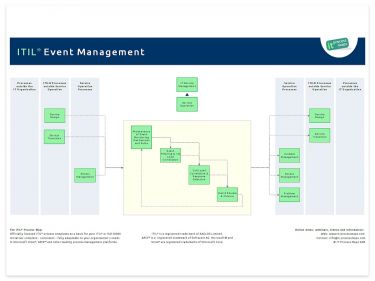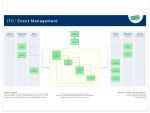Event Management: Difference between revisions
| Line 8: | Line 8: | ||
<br style="clear:both;"/> | <br style="clear:both;"/> | ||
<p> </p> | |||
The objective of ''ITIL Event Management'' is to make sure CIs and services are constantly monitored. ''Event Management'' aims to filter and categorize Events in order to decide on appropriate actions. | The objective of ''ITIL Event Management'' is to make sure CIs and services are constantly monitored. ''Event Management'' aims to filter and categorize Events in order to decide on appropriate actions if required. | ||
'''Part of''': [[ITIL V3 Service Operation|Service Operation]] | '''Part of''': [[ITIL V3 Service Operation|Service Operation]] | ||
| Line 18: | Line 18: | ||
<p> </p> | <p> </p> | ||
== | == ITIL Event Management == | ||
==== Process Description ==== | |||
Essentially, the activities and process objectives of the Event Management process are identical in ITIL V3 and V2 (Event Management is part of ICT Infrastructure Management in ITIL V2). | Essentially, the activities and process objectives of the Event Management process are identical in ITIL V3 and V2 (Event Management is part of ICT Infrastructure Management in ITIL V2). | ||
Interfaces between Event Management and the other ITIL processes were adjusted in order to reflect the new ITIL | [[Image:Event-management-itil.jpg|right|thumb|375px|alt=Event Management ITIL|[https://wiki.en.it-processmaps.com/images/pdf/process_overview_event_management_itilv3.pdf ITIL Event Management]]] | ||
Interfaces between [[Event Management]] and the other ITIL processes were adjusted in order to reflect the new ITIL process structure in ITIL 2007. | |||
In ITIL 2011 Event Management has been updated to reflect the concept of [[Event Management#ITIL Event 1st Level Correlation|1st Level Correlation]] and [[Event Management#Event Management 2nd Level Correlation|2nd Level Correlation]]. The process flows (''see Fig. 1'') reflect the more detailed guidance in the ITIL 2011 books. | |||
= | <span id="Sub-Processes">''These are the [[Event Management|ITIL Event Management]] sub-processes:''</span> | ||
<p> </p> | |||
;Maintenance of Event Monitoring Mechanisms and Rules | ;Maintenance of Event Monitoring Mechanisms and Rules | ||
:Process Objective: To set up and maintain the mechanisms for generating meaningful [[Event Management#Event Record|Events]] and effective rules for their filtering and [[Event Management#Event | :Process Objective: To set up and maintain the mechanisms for generating meaningful [[Event Management#Event Record|Events]] and effective rules for their filtering and [[Event Management#Event Filtering and Correlation Rules|correlating]]. | ||
;Event Filtering and | ;<span id="ITIL Event 1st Level Correlation">Event Filtering and 1st Level Correlation</span> | ||
:Process Objective: To [[Event Management#Event | :Process Objective: To [[Event Management#Event Filtering and Correlation Rules|filter out]] Events which are merely informational and can be ignored, and to communicate any Warning and Exception [[Event Management#Event Record|Events]]. | ||
;<span id="Event Management Correlation"> | ;<span id="Event Management 2nd Level Correlation">2nd Level Correlation and Response Selection</span> | ||
:Process Objective: To interpret the meaning of an [[Event Management#Event Record|Event]] and select a suitable response. | :Process Objective: To interpret the meaning of an [[Event Management#Event Record|Event]] and select a suitable response. | ||
;Event Review and Closure | ;<span id="ITIL Event Management Review">Event Review and Closure</span> | ||
:Process Objective: To check if [[Event Management#Event Record|Events]] have been handled appropriately | :Process Objective: To check if [[Event Management#Event Record|Events]] have been handled appropriately and may be closed. This process also makes sure that Event logs are analyzed in order to identify [[Event Management#Event Trends and Patterns|trends or patterns]] which suggest corrective action must be taken. | ||
<p> </p> | <p> </p> | ||
== ITIL Terms | ==== ITIL Terms ==== | ||
;<span id="Event">Event</span> | ;<span id="Event">Event</span> | ||
:see [[Event Management#Event Record|Event Record]] | :see [[Event Management#Event Record|Event Record]] | ||
;<span id="Event | ;<span id="Event Categorization Scheme">Event Categorization Scheme</span> | ||
:Rules and criteria used to decide upon an appropriate response | :The Categorization Scheme for Events supports a consistent approach to dealing with specific types of Events. Ideally, this scheme should be harmonized with the schemes to categorize CIs, Incidents and Problems. | ||
;<span id="Event Filtering and Correlation Rules">Event Filtering and Correlation Rules</span> | |||
:Rules and criteria used to determine if an Event is significant and to decide upon an appropriate response. [[Event Management#Event Management Correlation|Filtering and Correlation]] Rules are typically used by Event Monitoring systems. Some of those rules are defined during the Service Design stage, for example to ensure that Events are triggered when the required service availability is endangered. | |||
;<span id="Event Record">Event Record</span> | ;<span id="Event Record">Event Record</span> | ||
| Line 60: | Line 64: | ||
<p> </p> | <p> </p> | ||
==== ITIL Roles ==== | ==== ITIL Roles ==== | ||
;<span id="IT Operations Manager">IT Operations Manager - Process Owner</span> | ;<span id="IT Operations Manager">IT Operations Manager - Process Owner</span> | ||
:An IT Operations Manager will be needed to take overall responsibility for all of the [[IT Operations | :An IT Operations Manager will be needed to take overall responsibility for all of the [[IT Operations Control|IT Operations]] activities. He will ensure that all day-to-day operational activities are carried out in a timely and reliable way. | ||
;IT Operator | ;IT Operator | ||
| Line 74: | Line 76: | ||
<p> </p> | <p> </p> | ||
== | ==== Downloads ==== | ||
{| | {| | ||
| Line 82: | Line 82: | ||
Use the following links to open the process overview of Event Management showing the most important interfaces: | Use the following links to open the process overview of Event Management showing the most important interfaces: | ||
* [[Media: | * [[Media:Event-management-itil.jpg|ITIL Event Management (.JPG)]] | ||
* [https://wiki.en.it-processmaps.com/images/pdf/process_overview_event_management_itilv3.pdf ITIL Event Management (.PDF)]'' | * [https://wiki.en.it-processmaps.com/images/pdf/process_overview_event_management_itilv3.pdf ITIL Event Management (.PDF)]'' | ||
| valign="top" | | | valign="top" | | ||
[[Image: | [[Image:Event-management-itil.jpg|thumb|150px|left|none|alt=ITIL Event Management|ITIL Event Management at a glance]] | ||
|- | |- | ||
|} | |} | ||
<p> </p> | |||
<!-- This page is assigned to the following categories: --> | <!-- This page is assigned to the following categories: --> | ||
[[Category:ITIL V3]][[Category:ITIL process]][[Category:Service Operation|Event Management]][[Category:Event Management|!]] | [[Category:ITIL V3]][[Category:ITIL process]][[Category:Service Operation|Event Management]][[Category:Event Management|!]] | ||
<!-- --- --> | <!-- --- --> | ||
Revision as of 19:12, 9 October 2011
<seo metakeywords="itil event management, event management itil, event management process, itil v3 event management, event management itil" metadescription="Event Management: ITIL process definition - Sub-processes - Terms - Additional information on ITIL Event Management." />

The objective of ITIL Event Management is to make sure CIs and services are constantly monitored. Event Management aims to filter and categorize Events in order to decide on appropriate actions if required.
Part of: Service Operation
Process Owner: IT Operations Manager
ITIL Event Management
Process Description
Essentially, the activities and process objectives of the Event Management process are identical in ITIL V3 and V2 (Event Management is part of ICT Infrastructure Management in ITIL V2).

Interfaces between Event Management and the other ITIL processes were adjusted in order to reflect the new ITIL process structure in ITIL 2007.
In ITIL 2011 Event Management has been updated to reflect the concept of 1st Level Correlation and 2nd Level Correlation. The process flows (see Fig. 1) reflect the more detailed guidance in the ITIL 2011 books.
These are the ITIL Event Management sub-processes:
- Maintenance of Event Monitoring Mechanisms and Rules
- Process Objective: To set up and maintain the mechanisms for generating meaningful Events and effective rules for their filtering and correlating.
- Event Filtering and 1st Level Correlation
- Process Objective: To filter out Events which are merely informational and can be ignored, and to communicate any Warning and Exception Events.
- 2nd Level Correlation and Response Selection
- Process Objective: To interpret the meaning of an Event and select a suitable response.
- Event Review and Closure
- Process Objective: To check if Events have been handled appropriately and may be closed. This process also makes sure that Event logs are analyzed in order to identify trends or patterns which suggest corrective action must be taken.
ITIL Terms
- Event
- see Event Record
- Event Categorization Scheme
- The Categorization Scheme for Events supports a consistent approach to dealing with specific types of Events. Ideally, this scheme should be harmonized with the schemes to categorize CIs, Incidents and Problems.
- Event Filtering and Correlation Rules
- Rules and criteria used to determine if an Event is significant and to decide upon an appropriate response. Filtering and Correlation Rules are typically used by Event Monitoring systems. Some of those rules are defined during the Service Design stage, for example to ensure that Events are triggered when the required service availability is endangered.
- Event Record
- A record describing a change of state which has significance for the management of a Configuration Item or service. The term Event is also used to mean an alert or notification created by any IT service, Configuration Item or monitoring tool. Events often require IT operations personnel to take actions, and may lead to Incidents being logged.
- Event Trends and Patterns
- Any trends and patterns identified during analysis of significant Events, which suggest that improvements to the infrastructure are needed.
ITIL Roles
- IT Operations Manager - Process Owner
- An IT Operations Manager will be needed to take overall responsibility for all of the IT Operations activities. He will ensure that all day-to-day operational activities are carried out in a timely and reliable way.
- IT Operator
- IT Operators are the staff who perform the day-to-day operational activities.
- Typical responsibilities include: Performing backups, ensuring that scheduled jobs are performed, installing standard equipment in the data center.
Downloads
|
Use the following links to open the process overview of Event Management showing the most important interfaces: |
 |






